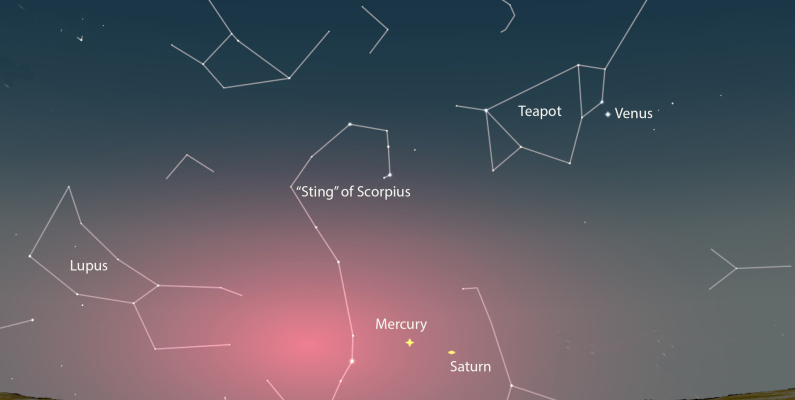
As darkness falls this week, there’s a fine celestial display in the south-western sky as the planet Mercury pops into view and sails past Saturn. With the sun setting at about 9pm there really is no excuse for local stargazers not to hotfoot it to a local beauty spot with a good view to the south-west and enjoy the spectacle.
Once the sun has set, the planet Venus will be the first object you will see as the sky darkens. Often mistaken for an unidentified flying object, the second planet from the sun is spectacularly bright; at sunset it stands just about twenty degrees (or one handspan at arm’s length) above the WSW horizon. Venus is just to the right of a very distinctive group of stars that resemble a teapot. They are part of the constellation Sagittarius. Once it’s dark enough to see the teapot’s stars clearly, we can use it as a jumping-off point on our hunt for Mercury and Saturn.
After finding Venus, and the teapot, cast your gaze to the left. It should be very easy to see another distinct pattern of stars which resembles a reversed question mark. This is the sting of the constellation Scorpius. Once you’ve found this, follow the line of stars downwards, until you spot the bright star Antares. With Antares in sight, look to the right; it should be easy to see both Mercury and Saturn. Mercury should appear noticeably brighter and slightly higher in the sky than Antares, while Saturn will appear to be roughly the same brightness as the orange star.
Spotting Mercury and Saturn this week will not be easy, because they are highest in the sky at sunset and both sink below the horizon before 10.30pm so you have less than ninety minutes to find them. As our chart shows, they are closest together on the night of 22 November; on subsequent nights Mercury will be progressively higher in the sky and Saturn will become more and more difficult to see at all as it gets closer to the sun.

